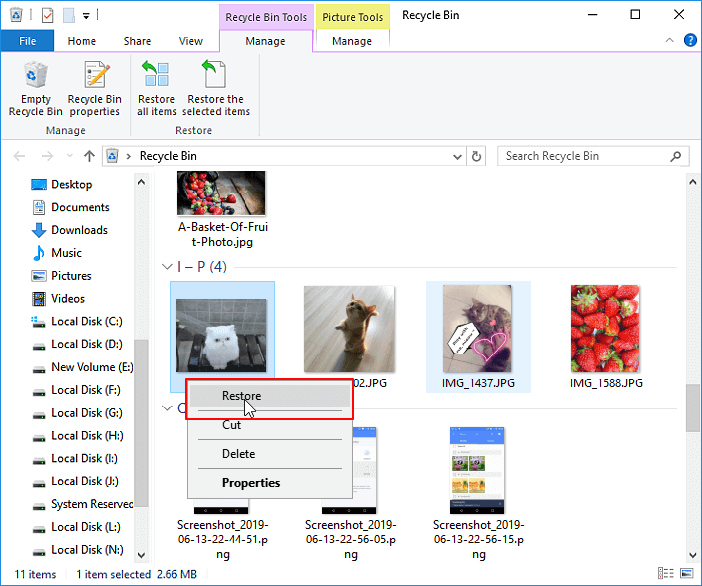JPG Recovery: How to Recover Deleted or Lost JPG/JPEG Files
JPG/JPEG is a widely used digital image compression standard that offers high resolution, small file size, and adjustable compression. It's one of the most popular formats for digital photos, commonly used on cameras, mobile phones, and the internet. JPG/JPEG files are saved with the .jpg or .jpeg extension by default, and are often used as the default format for photos taken with digital cameras and mobile devices. This format is also compatible with most websites and services, making it a convenient choice for sharing and storing photos.
Overview of JPG Recovery
If you've lost JPG/JPEG files, the key to recovering them is whether data has been overwritten after deletion. If not, you can try retrieving them from the recycle bin or using data recovery software. However, if data overwriting has occurred, the chances of recovering your lost files are relatively low.
What Causes The Loss of JPG/JPEG Files
JPG/JPEG files are commonly used and often lost due to various reasons. Whether stored on devices like digital cameras, mobile phones, or storage media like computer hard drives, USB, or memory cards, photos can be lost due to accidental deletion, formatting, corruption, or physical damage to the storage device.
- Accidental deletion
- Storage device formating
- Virus attacks or malware infection
- Other accidents like a power failure or system crash
The good news is that you can recover JPG/JPEG files with the help of hard drive recovery software, specifically Deep Data Recovery.
How to Recover JPG or JPEG Files
Deep Data Recovery can be used to recover JPG/JPEG files from various devices, including cameras, computer hard drives, and external storage devices. The tool also supports recovery of other image formats, such as PNG, BMP, GIF, and RAW, and can repair corrupted photos automatically during the recovery process.
Deep Data Recovery is a powerful tool that goes beyond just JPG recovery, offering a wide range of capabilities to help you recover and manage your data.
- The software can recover almost all existing file types, including photos, videos, audio files, documents, and Adobe files, among others.
- Recover lost data from various devices with a data recovery service, including computer hard drives, external hard drives, USBs, memory cards, digital cameras, camcorders, and video players.
- Recover files after deletion, formatting, emptying the Recycle Bin, partition loss, hard disk damage, and other challenging data loss situations with advanced data recovery software. These tools can scan your storage device, locate deleted or lost files, and recover them in their original format, even if they've been overwritten or corrupted.
Download the software on your computer and follow the detailed guide below to get started.
Step 1. Choose the file types to start
Select the file type you want to recover, then click "Next".

Step 2. Choose the location and start scanning
To recover deleted/lost pictures, hover on the SD card, camera, or hard drive partition where you deleted/lost pictures, then click "Scan".

Step 3. Select the pictures you want to recover
After the scanning process is complete, navigate to the "Pictures" section in the left panel. To locate the lost photos, click on "Lost" at the top of the list. From there, you can browse through the photos by device, type, and date to find the ones you're looking for.

Step 4. Recover lost photos
After the preview, click "Recover" and choose another location to save the desired pictures.
Recover JPG/JPEG from Recycle Bin
Here are the detailed steps to recover deleted JPG files from the Recycle Bin:
Step 1. Enter the recycle bin on your computer.
Step 2. Find the picture that you want to recover.
Step 3. Right-click the picture and choose "Restore".

The Bottom Line
When unexpected photo loss occurs, stop using the storage device to prevent data overwriting and apply data recovery software to perform JPG/JPEG/PNG recovery immediately, ensuring a high success rate. Additionally, Deep Data Recovery can help restore corrupted JPG/JPEG files during the recovery process, working unnoticed but providing significant assistance. By getting the software, you can retrieve your photos within minutes.
Related Articles
- Files/Folders Keep Reappearing After Deletion in Windows 10/8/7
- Fallout 4 Accidentally Deleted Saves, How to Recover?
- Microsoft's Windows File Recovery Tool Full Review
- Hard Drive Not Showing Up or Detected in Windows? Learn How to Fix